By Pete DeWeese
Special Assignment Researcher (X&O Labs)
Offensive Coordinator
Sprayberry High School (GA)
Introduction
The zone read has been a cornerstone in spread offenses for over twenty years, and Clemson’s system uses it as well. The difference lies in how Clemson runs its zone run game. Every zone run in Clemson’s offensive menu has built in components- whether it’s a blocking adjustment or an RPO. The zone read is option football at it’s core which means an offensive coordinator will design the concept with whom he wants to carry the ball in mind. For Clemson’s athletes, both the quarterback and running back can pose significant threats to the defense. While carriers by both these ball carriers can alter from season to season, one thing is clear: the threat of a dual quarterback in this system makes a defense have to account for him.
What is a Zone Run?
The difference in a zone run as compared to a gap run relies on the intended horizontal displacement of defenders. The zone scheme can be a wider scheme than a gap scheme and has the potential to stretch defenders, opening up entry points for the back in the run box. When it’s coupled with the quarterback read element (where he is reading a particular defender to either give or keep the ball) the zone run game forces defenses to tie at least one defender in playing the quarterback pull element. It’s the perfect complement to gap schemes because it presents a completely different feel for the defense and can cause them to misfit the scheme.
Why zone runs are effective in this system?
Clemson is effective in these schemes for various reasons. The inside zone variations are a major part of their tempo game because it’s easy to execute when moving fast. Since there are no pull involved along the line of scrimmage, blocking assignments are easier to communicate along the front. There are less moving parts to these run concepts than there are in gap schemes. Another way in which Clemson is effective in these schemes it the wide path that the quarterback takes on almost all of his pull reads. Many coaches tell the quarterack to pull and replace (the read key), but Clemson’s quarterbacks work wider. Another reason for the success of these concepts is the discipline of Clemson’s running backs who do a great job of “bouncing” their fake when the QB pulls the ball, often blocking (or gettign tackled by) an extra defender.
Types of Zone Runs Clemson Utilizes
Zone Read Concept
Formation Variations
In most scenarios, the zone read concept can be thwarted by a gap exchange with a linebacker, allowing the defensive end to chase the dive back while the second level linebacker can come over the top to play the quarterback. While this is a standard way of playing the zone read option, Clemson relies on building different formation structures to force defenses to be out leveraged when defending the zone read game. Most of these formation structures fit into two main categories:
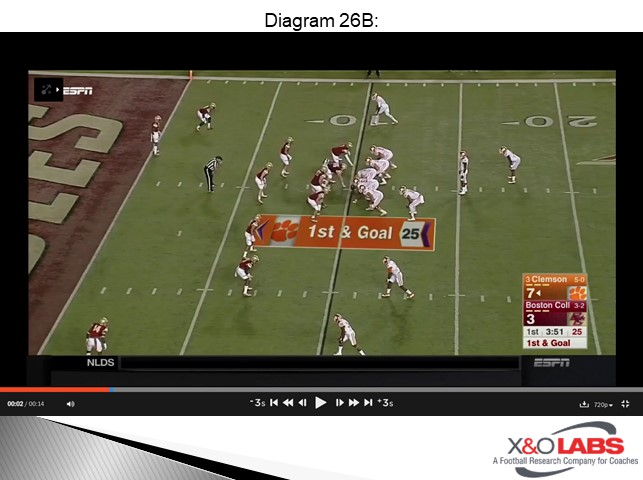
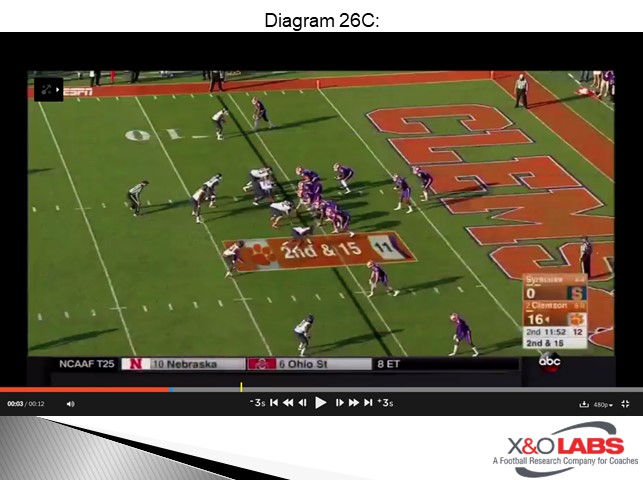
How Clemson produces these formations relies on the use of an off the line tight end or H-back. Because he is off the line of scrimmage, he can insert anywhere along the LOS or on the perimeter. The ability of the tight end to be also an effective slot receiver reduces the need to substitute and allows the Tigers to go up tempo. It was a formation initially made popular in the coaching profession by Gus Malzahn and his staff at Auburn. Now it’s nearly impossible to watch a college football game without seeing at least one team utilizing this formation. How Clemson uses that H in its zone read game is at the crux of the success of its run game.
3x1 Formation Structures
King Weak Formation
Placing the back away from the trips formation, allows Clemson to attack the weak-side of the defense. If a team wants to play a 2-high safety coverage, this alignment can really help attack the space voided by a deep safety to the single wide receiver side. The same is true for a defense that rotates the strong safety down over the two receivers but does not walk a defender outside of the weak B-gap to fil the “apex” of the formation.
In the illustration below, Clemson uses this formation for their zone run game. With the ball on the left hash, Clemson puts two wide receivers to the field and aligns the H-back off the ball and on the outer half of the offensive tackle to the same side. Florida State tries to add a seventh player to the box by locking up on the outside and spinning the field safety down into the box to take the H-back one-on-one or become an extra fitter in the box. They marry this coverage with a boundary pressure with the Will LB coming off of the edge (Diagram 27).
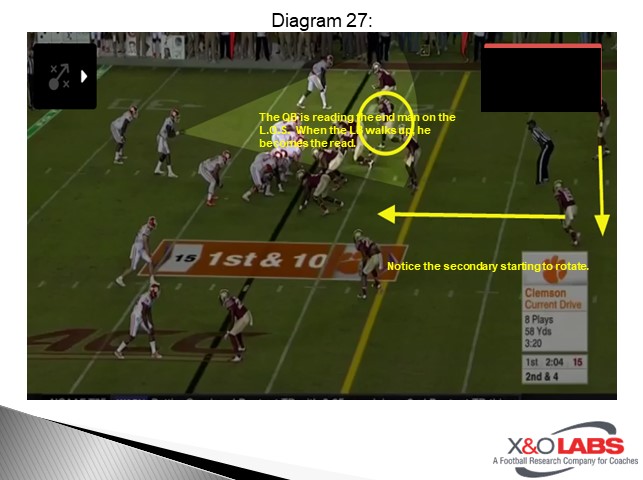
But as the left tackle works his zone track, the boundary defensive end (who is likely supposed to be slanting inside to B Gap) gets stuck outside. As a result, Florida State ends up with two defenders in C gap. As the blitz happens, the quarterback reads the outside linebacker that has become the new end man on the line of scrimmage. Since the boundary safety has rotated towards the middle of the field to execute his Cover 1 assignment, and the corner is matched up in man-to-man, the quarterback is able to attain a numbers advantage turn this into a big gain (Diagram 28).
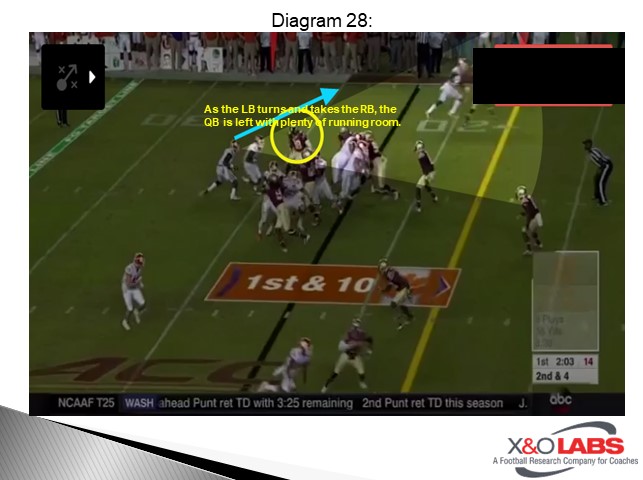
King Strong Formation
Clemson will also put its A back to the side of the trips, which can be more ideal for attacking single high safety structures. Placing the running back to the passing strength (along with the H) puts four players to a side. If the defense rotates a safety down over the slot, Clemson can still account for the outside linebacker when running zone read that direction. This makes it easier to match hats.
In the clip below, Clemson goes back to this familiar formation. In this game Florida State seems to bounce back and forth from some Even fronts to some Odd front defenses. On this play FSU is essentially playing a Bear front, with five defenders at the line of scrimmage. To the strength of the formation they have a head up 4-technique that spikes inside to take B gap on the snap of the ball. The head up nose appears to be two-gapping the center while the backside end is aligned in a loose 3-Technique and attacks the guard on the snap of the ball. To the weak side, FSU has a stand-up backer playing C gap. Clemson has an immediate numbers advantage (Diagram 29).
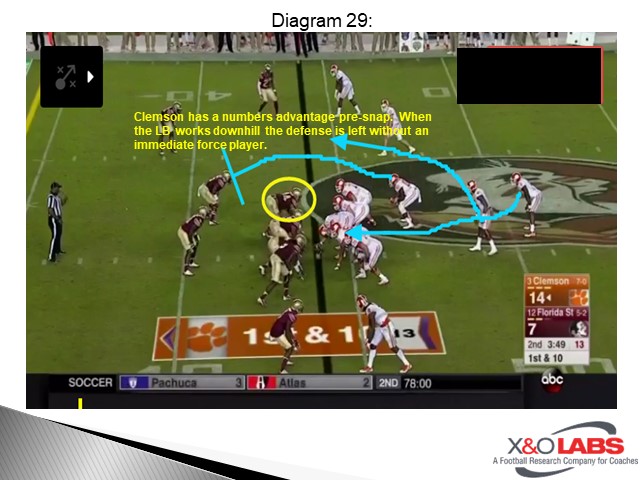
Special Assignment Researcher (X&O Labs)
Offensive Coordinator
Sprayberry High School (GA)
Introduction
The zone read has been a cornerstone in spread offenses for over twenty years, and Clemson’s system uses it as well. The difference lies in how Clemson runs its zone run game. Every zone run in Clemson’s offensive menu has built in components- whether it’s a blocking adjustment or an RPO. The zone read is option football at it’s core which means an offensive coordinator will design the concept with whom he wants to carry the ball in mind. For Clemson’s athletes, both the quarterback and running back can pose significant threats to the defense. While carriers by both these ball carriers can alter from season to season, one thing is clear: the threat of a dual quarterback in this system makes a defense have to account for him.
What is a Zone Run?
The difference in a zone run as compared to a gap run relies on the intended horizontal displacement of defenders. The zone scheme can be a wider scheme than a gap scheme and has the potential to stretch defenders, opening up entry points for the back in the run box. When it’s coupled with the quarterback read element (where he is reading a particular defender to either give or keep the ball) the zone run game forces defenses to tie at least one defender in playing the quarterback pull element. It’s the perfect complement to gap schemes because it presents a completely different feel for the defense and can cause them to misfit the scheme.
Why zone runs are effective in this system?
Clemson is effective in these schemes for various reasons. The inside zone variations are a major part of their tempo game because it’s easy to execute when moving fast. Since there are no pull involved along the line of scrimmage, blocking assignments are easier to communicate along the front. There are less moving parts to these run concepts than there are in gap schemes. Another way in which Clemson is effective in these schemes it the wide path that the quarterback takes on almost all of his pull reads. Many coaches tell the quarterack to pull and replace (the read key), but Clemson’s quarterbacks work wider. Another reason for the success of these concepts is the discipline of Clemson’s running backs who do a great job of “bouncing” their fake when the QB pulls the ball, often blocking (or gettign tackled by) an extra defender.
Types of Zone Runs Clemson Utilizes
- Zone Read
- QB Draw
Zone Read Concept
Formation Variations
In most scenarios, the zone read concept can be thwarted by a gap exchange with a linebacker, allowing the defensive end to chase the dive back while the second level linebacker can come over the top to play the quarterback. While this is a standard way of playing the zone read option, Clemson relies on building different formation structures to force defenses to be out leveraged when defending the zone read game. Most of these formation structures fit into two main categories:
- Trips Formation Structures- three receivers are placed to one side of the formation (Diagram 26B).
- Doubles Formation Structures- two receivers are placed to both sides of the formation (Diagram 26C).


How Clemson produces these formations relies on the use of an off the line tight end or H-back. Because he is off the line of scrimmage, he can insert anywhere along the LOS or on the perimeter. The ability of the tight end to be also an effective slot receiver reduces the need to substitute and allows the Tigers to go up tempo. It was a formation initially made popular in the coaching profession by Gus Malzahn and his staff at Auburn. Now it’s nearly impossible to watch a college football game without seeing at least one team utilizing this formation. How Clemson uses that H in its zone read game is at the crux of the success of its run game.
3x1 Formation Structures
King Weak Formation
Placing the back away from the trips formation, allows Clemson to attack the weak-side of the defense. If a team wants to play a 2-high safety coverage, this alignment can really help attack the space voided by a deep safety to the single wide receiver side. The same is true for a defense that rotates the strong safety down over the two receivers but does not walk a defender outside of the weak B-gap to fil the “apex” of the formation.
In the illustration below, Clemson uses this formation for their zone run game. With the ball on the left hash, Clemson puts two wide receivers to the field and aligns the H-back off the ball and on the outer half of the offensive tackle to the same side. Florida State tries to add a seventh player to the box by locking up on the outside and spinning the field safety down into the box to take the H-back one-on-one or become an extra fitter in the box. They marry this coverage with a boundary pressure with the Will LB coming off of the edge (Diagram 27).

But as the left tackle works his zone track, the boundary defensive end (who is likely supposed to be slanting inside to B Gap) gets stuck outside. As a result, Florida State ends up with two defenders in C gap. As the blitz happens, the quarterback reads the outside linebacker that has become the new end man on the line of scrimmage. Since the boundary safety has rotated towards the middle of the field to execute his Cover 1 assignment, and the corner is matched up in man-to-man, the quarterback is able to attain a numbers advantage turn this into a big gain (Diagram 28).

King Strong Formation
Clemson will also put its A back to the side of the trips, which can be more ideal for attacking single high safety structures. Placing the running back to the passing strength (along with the H) puts four players to a side. If the defense rotates a safety down over the slot, Clemson can still account for the outside linebacker when running zone read that direction. This makes it easier to match hats.
In the clip below, Clemson goes back to this familiar formation. In this game Florida State seems to bounce back and forth from some Even fronts to some Odd front defenses. On this play FSU is essentially playing a Bear front, with five defenders at the line of scrimmage. To the strength of the formation they have a head up 4-technique that spikes inside to take B gap on the snap of the ball. The head up nose appears to be two-gapping the center while the backside end is aligned in a loose 3-Technique and attacks the guard on the snap of the ball. To the weak side, FSU has a stand-up backer playing C gap. Clemson has an immediate numbers advantage (Diagram 29).










